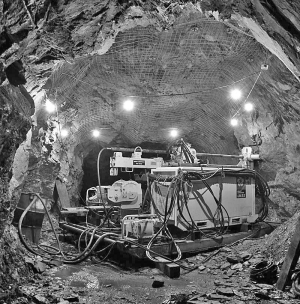Vancouver — With dewatering complete and a prefeasibility study under way, Rambler Metals and Mining (RAB-v) continues to hit strong copper and gold grades at its namesake property in Newfoundland.
The Rambler property consists of two old mines, the Ming and Ming West underground operations, on the Baie Verte Peninsula. Ming last operated in 1982, after producing some 2.1 million tonnes of ore averaging 3.5% copper and 2.5 grams gold per tonne over 10 years. Ming West operated for just two years in the mid-1990s and in that time, produced 271,000 tonnes grading 4% copper and 5.8 grams gold. The mine shut down when workings reached a property boundary.
In 2001, Rambler Metals consolidated the properties covering the old mines and the surrounding area. The company started exploring from surface, as the old workings were flooded. When surface drilling indicated the mineralization did indeed extend beyond the historically mined areas, the company set to work dewatering the workings.
With dewatering under way, the company calculated a resource for the property. Measured resources came in at 484,000 tonnes averaging 2.98% copper, 2.28 grams gold, 9.6 grams silver and 0.61% zinc. Indicated resources totalled 9.6 million tonnes grading 1.78% copper, 0.2 gram gold, 1.75 grams silver and 0.04% zinc. Inferred resources add 3.1 million tonnes grading 1.57% copper, 0.58 gram gold, 4.29 grams silver and 0.24% zinc.
The 1807 zone carries the highest grades on the property, with better than 4% copper and 1.5 grams gold in all categories. The study determined Ming still holds enough resources to sustain a 4,000-tonne-per- day operation over a 12-year mine life.
Rambler Metals completed the dewatering in July, after pumping 245 million gallons of water out of the Ming mine, and moved drill rigs underground. Results from that drilling are now starting to come in.
The key finding is the 1806 zone, which along with the 1807 zone, is part of a massive sulphide horizon, and hosts significant gold, copper and zinc grades. The zone has now been traced for 250 metres plunge, 20 metres of strike, and 10 metres width. Recent results from 1806 include a 9.5-metre intercept in hole 142 that averaged 20.31 grams gold, 4.21% copper and 4.31% zinc, as well as 15.8 metres in hole 139 grading 7.64 grams gold, 0.74% copper and 4.19% zinc.
In a previous set of results from the 1806 zone, hole 120 hit 28.8 metres grading 10.86 grams gold, 0.77% copper and 2.47% zinc, including 30.93 grams gold, 2.14% copper and 7.98% zinc over 8.7 metres. Hole 123 then cut 17.9 metres grading 10.81 grams gold, 0.8% copper and 3.21% zinc.
A historical face sample on the 2,200-level of the Ming mine returned 15.6 grams gold over 2.7 metres. Rambler geologists believe the sample could be from 1806 down-plunge; if true, that means 1806 plunges more than 1,000 metres. The company is drill-testing this theory.
Regardless of its plunge extent, the 1806 zone will form an important part of the initial mining plan as access drifts have already reached the zone. The high gold grades are a bonus for a company looking to start operations.
Over in the Lower Footwall zone, historic drilling intersected broad zones of stringer-type mineralization carrying 2% copper over varying widths. Rambler has punched holes into the zone to test historic results and the new core is grading better than the old.
It seems the Lower Footwall is capable of carrying 2% copper or better over significant distances. Hole 103, for example, cut 14.3 metres grading 0.12 gram gold and 2.36% copper, while hole 114 returned 4 metres grading 0.25 gram gold and 4.48% copper. Ramblers Metals has more drilling planned for the Lower Footwall to increase confidence in that zone’s mineralization.
And the company is also looking to boost resources by mining out the remnant pillars from the historic operation. When the mine closed, it left roughly 453,000 tonnes of 3.7% copper and 1.88 grams gold in the pillars, which were not mined because the caves were not backfilled. Rambler is working to confirm those historic resource numbers.
While the company still has considerable exploration work to complete, it is also looking to production options. The recent resource estimate concluded that Rambler could support a 4,000-tonne-per-day operation. However, to achieve that rate would require substantial investments of time and capital. As such, Rambler is focusing internal plans on smaller-scale mining of the 1807 and 1806 zones, closer to the historical rate of 650 tonnes per day. The approach should allow for more rapid startup, while also minimizing startup capital.
The company started a prefeasibility study a few months ago and continues its underground drilling efforts in advance of an updated resource estimate, due out in early 2009.


Be the first to comment on "Rambler focused on Ming"